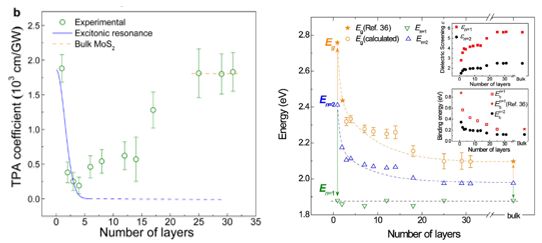Layered transition metal dichalcogenides (TMDCs) exhibit unique nonlinear optical properties, including high-order harmonic generation, ultrafast saturable absorption, optical limiting and multi-photon absorption. However, questions hovering over the modulation of bandgap size and excitonic effect on nonlinear absorption have restricted their applications in micro/nano optical modulator, optical switching and beam shaping devices.
Recently, a study led by Prof. WANG Jun from Shanghai Institute of Optics and Fine Mechanics, Chinese Academy of Sciences, investigated the layer dependent degenerate two-photon absorption (TPA) behavior in the near-infrared region in MoS2 from single layer to multilayer and found the TPA coefficients modulation rule by the detuning of the excitonic dark state. This study has been published online in Photonics Research.
In their experiment, MoS2 nanosheets with different thickness ranging from monolayer to 31 layers (31L) were mechanically exfoliated from the bulk crystal and then transferred to quartz substrates, as it would affect the light absorption extremely weakly. The TPA properties were studied using the micro-I-scan technique with 340 fs laser pulses at 1030 nm generated from a mode-locked fiber laser.
They further extracted the TPA coefficients through numerical fitting and found the monolayer MoS2 exhibited the largest TPA coefficient, and then it declined rapidly until ~4 layers. After that, the TPA coefficient gradually increased from few-layer to multilayer up to 25 layers.
Combining the non-hydrogen model of excitons in TMDCs with the scaling rule in semiconductors, they deduced the red shift of the 2p excitonic dark state and the band-edge of conduction band with increasing layer number. The quasiparticle bandgap and excitonic dark levels, as well as the binding energy of the exciton dark state dropped dramatically until the layer number increased to 25L, which implies this is the 2D-to-bulk transition point. The sharp decline of the TPA coefficient from monolayer to ~4L could be ascribed to the on-off resonance of 2p excitonic dark states. In addition, they demonstrated the sub-band resonance in the conduction band.
These results provide valuable insights into the mechanism of the evolution of band structure and excitonic levels in layered MoS2, which can be applied to other TMDCs. It clearly demonstrates the layer modulation of nonlinear absorption in TMDCs and provide support for layer-dependent nonlinear optical devices, such as optical limiters and optical switches.
This work was supported by the Chinese National Natural Science Foundation, the Strategic Priority Research Program of CAS, the Key Research Program of Frontier Science of CAS, and the Program of Shanghai Academic Research Leader.

Fig. 1 TPA coefficients, shift of the quasiparticle bandgap Eg and the first excited excitonic state (En=2) versus number of layers in MoS2 nanosheets.
Article website:
https://www.osapublishing.org/prj/abstract.cfm?uri=prj-7-7-762
Contact:
Mr. Cao Yong
General Administrative Office
Shanghai Institute of Optics and Fine Mechanics, CAS
Email: caoyong@siom.ac.cn